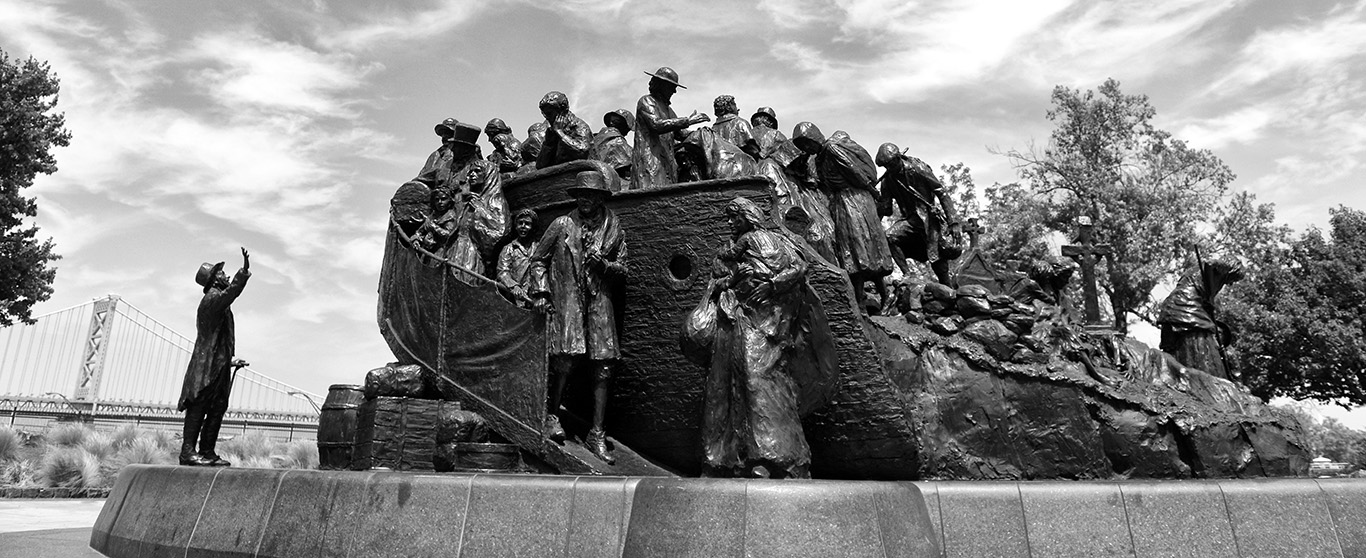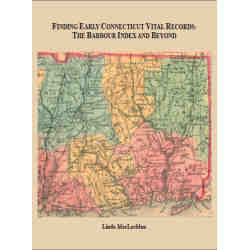
Between 1717 and the beginning of the War of American Independence in 1776, 250,000 Scots-Irish, often referred to as Ulster-Scots in Ireland (i.e. Protestant settlers in the nine counties of the Province of Ulster) left Ulster, through the ports of Belfast, Londonderry, Newry, Larne and Portrush, for North America. The Scots-Irish tended to enter North America through Philadelphia and they headed for the frontier; of 128 vessels advertised to sail from Derry between 1750 and 1775, 99 of them sailed for Philadelphia.
From Philadelphia the Scots-Irish then poured across the Susquehanna into the Cumberland Valley. From the 1740s they moved southwards through the Great Valley, east of the Appalachian Mountains, across the Potomac and into the Shenandoah Valley (also known as the Valley of Virginia) between the Blue Ridge and Appalachian ranges. From there they continued south into the Piedmont of North and South Carolina. By the Revolutionary War, in 1776, about 90% of Ulster settlers had made their homes in Pennsylvania, the Valley of Virginia and the Carolinas; and they dominated a one-thousand-mile frontier along the spine of Appalachia from Pennsylvania to South Carolina.
James Buchanan of Ramelton, County Donegal departed from Londonderry for Philadelphia on the ship Providence on 4 June 1783. James established a trading post at Cove Gap, Pennsylvania in the Allegheny Mountains, married Elizabeth Spear, and, on 23 April 1791, their son, James Buchanan, who was to become the 15th President of the USA from 1857 to 1861, was born.
It was said of the early settlers in Pennsylvania that the Quakers were better traders, the Germans better farmers and the Ulster-Scots were best at coping with frontier conditions.
Family Connections among Merchant Community in Derry and Philadelphia
The linen and emigration trade established Derry as one of the chief Irish ports for transatlantic trade in the 18th century. Flaxseed, the raw material of the linen industry, was shipped to Derry from Philadelphia in the early spring, and on the return voyage linen and emigrants were destined for Philadelphia.
In 1768 flaxseed comprised half the value of Irish imports from the American colonies. Linen goods were the chief cargo on the return journey to America. In 1772 linen goods comprised over 80% of the value of Derry’s total exports to the colonies. With the substitution of linen goods for bulky flaxseed there was ample space for emigrants in the outgoing vessels.
It is clear that strong trade links, reinforced by family connections in the mercantile community, developed in the 18th century between the ports of Londonderry and Philadelphia.
Captain Conolly McCausland of Streeve Hill (near Limavady, County Derry) was assisting mass emigration from the Roe Valley, County Derry as commander of ships, Walworth, Jane and Faithful Steward during the American Revolutionary period, 1768-1785. Conolly and his brother Abraham McCausland, merchant of Londonderry, were engaged in transatlantic trade together with their cousins Robert McCausland of Coleraine, County Derry and John Stirling of Walworth (near Ballykelly, County Derry).
Conolly McCausland captained the ship Walworth on a dozen or more voyages across the Atlantic between 1768 and 1773. The Walworth was a joint venture with Strabane-born (County Tyrone) Thomas Barclay of Philadelphia. Barlcay followed his uncle Samuel Carsan, also a Strabane emigrant, to Philadelphia, then the largest port in America. Carsan, joint owner of over 20 ships, built up the Philadelphia mercantile firm of Carsan and Davey. In the 1760s with Thomas Barclay’s arrival, a new partnership emerged: Carsan, Barclay and Mitchell. The third principal was William Mitchell, the son of James Mitchell of Londonderry.
19th Century Emigration and the Famine
There is still a tendency to see the Famine of 1846 to 1851, when over a million people left Ireland for North America, as the cause of the Irish Diaspora. Heavy emigration from Ireland began well before the Famine and continued well after it. With the end of the Napoleonic Wars in 1815 many small farmers, agricultural labourers and rural tradesmen in Ireland saw emigration as the only solution to their declining economic prospects. Emigration thus acted as a “safety valve,” enabling young men and women with little economic prospects to escape Ireland.
Derry’s importance as an emigration port continued to grow in the 19th century; it was a profitable trade. Merchants in Derry soon became ship-owners as opposed to agents for American and British companies. An outward cargo of emigrants, a homeward cargo of timber or grain, together with two voyages per year, one in spring and one in the autumn, ensured a sizeable profit. Two local companies, J & J Cooke and William McCorkell & Co. dominated transatlantic trade and, in the process, built up sizeable shipping fleets.
At the height of the Famine in 1847, of 12,385 emigrants leaving from Derry for North America, 5,104 or 41% were carried by J & J Cooke in 20 ships; 8 of these ships were destined for Philadelphia, 7 for Saint John, New Brunswick and 5 for Quebec.
In the 1860s the McCorkell Line demonstrated that first-class sailing ships could compete with steam on the North American passenger run. They had five ships plying between Derry and the cities of New York and Philadelphia: the Mohongo, Minnehaha, Stadacona, Village Belle and Lady Emily Peel.
The McCorkell family commissioned oil paintings of many, but not all, ships which sailed under the McCorkell flag from 1834 to 1897. Oil paintings were produced of the following McCorkell Line ships: Caroline, Erin, Harvester, Hiawatha, Minnehaha, Mohongo, Osseo, Oweenee, Village Belle and Wenonah. The Song of Hiawatha by H W Longfellow was a source of inspiration in the naming of many of the McCorkell ships, including their flag ship the Minnehaha.
DuPont Company and Irish Immigration
An examination of digital sources relating to ‘The Du Pont Company on the Brandywine’ at the Hagley Museum and Library, at https://www.hagley.org/research/digital-exhibits/sources, demonstrates that though their network of agents in Philadelphia the Company assisted many Irish immigrants. Du Pont enabled workers at their gunpowder works, established 1802, at Hagley along the banks of the Brandywine in Wilmington, Delaware to arrange for the passage of friends and relatives to Philadelphia.
Agents for the Company in Philadelphia included Andrew J. Catherwood from 1847 to 1854 and Robert Taylor from 1830 to 1850. These two men also acted as agents in middle years of 19th century for the two biggest shipowners in Derry; Andrew J Catherwood, from his Philadelphia office at ’62 North Second Street above Arch’, for J & J Cooke, and Robert Taylor for William McCorkell & Co.
Through paternalism of the DuPont Company and their network of agents in Philadelphia, Derry in the late 1820s and early1830s, became the leading city in Ireland and Britain dealing with pre-paid passages; hence the story of DuPont immigrants is part of the bigger story of Irish immigration and the port of Philadelphia. Indeed, it has been said that ‘the Londonderry to Philadelphia route was the oldest Irish emigrant trade route.’
The Irish Memorial at Penn’s Landing, Philadelphia
Opened to the public in 2003, the Irish Memorial, a national monument at Penn’s Landing, Philadelphia, is ‘dedicated to the memory of more than one million innocent men, women and children who perished during the years 1845 to 1850 and to the millions of Irish immigrants who found here in the United States of America the freedom, liberty and prosperity denied to their ancestors in Ireland.
The centerpiece of this project is a monumental bronze sculpture set in a 1.75 acre dedicated park (see above). Glenna Goodacre, the artist who sculpted the Vietnam Women’s Memorial in Washington, D.C., created the monument, including 35 life-sized figures. The bronze work measures a spectacular 30 feet long by 12 feet wide and 12 feet high. The memorial depicts the cruel starvation which claimed one million Irish lives between 1845 to 1850; the harrowing journey to America taken by a million more; and the indomitable spirit of those who arrived safely and resolved to face the challenges of life in a new world.’
Brian Mitchell
Derry Genealogy, 17 February 2023
See Brian Mitchell’s books on Derry or Northern Irish genealogy:
- Defenders of the Plantation of Ulster, 1641-1691
- Irish Emigration Lists, 1833-1839
- Irish Passenger Lists, 1803-1806
- Irish Passenger Lists, 1847-1871
- The People of Derry City, 1921
- The People of Derry City, 1930
- The Place Names of County Derry
- The Surnames of North West Ireland
- The Top 300 Surnames of Derry-Londonderry
- Tracing Derry-Londonderry Roots





Thanks for this informative article, Brian. I am interested in three men, Abraham, Randle and William Mitchell, who were merchants in Philadelphia in the 1760s and 1770s. I am trying to determine if these men were related to one another. You mentioned William’s father, James. Do you have other information about Jame, his business and his relations? I see that the will of James Mitchell, merchant of Londonderry, was probated in 1788.
Best regards,
Robert N. Fanelli